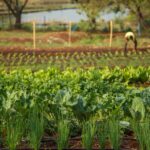Pruning is one of the most important vineyard practices for achieving higher grape yields and producing quality fruit. Whether you’re managing a small backyard vine or a commercial vineyard, how and when you prune can make a significant difference in your harvest. Proper pruning not only shapes the vine for optimal sun exposure and airflow but also balances fruit production and vegetative growth. By mastering the right techniques, grape growers can boost yield, improve berry quality, and maintain healthy vines year after year.
The foundation of effective pruning lies in understanding the grapevine’s growth cycle. Grapes produce fruit on one-year-old wood—shoots that grew the previous season. If left unpruned, the vine produces excessive foliage and fewer, lower-quality grapes. Winter is the ideal time for pruning, typically during dormancy between late June and early August in South Africa. This allows growers to clearly see the vine’s structure and remove unnecessary canes without damaging the plant.
One of the most widely used methods is spur pruning, especially for grape varieties grown on cordon-trained systems. In this method, the grower cuts back last season’s growth to short spurs with one to three buds each. These spurs will produce the fruiting canes for the coming season. Spur pruning helps control the number of fruiting buds and maintains an open canopy, reducing the risk of fungal diseases.
Another technique, cane pruning, is often used for varieties that produce better yields on longer canes, such as table grapes or some wine grape cultivars. Cane pruning involves selecting one or two strong canes from the previous season’s growth and cutting them back to 8 to 15 buds. The rest of the old wood is removed, allowing the vine to focus its energy on fewer but more productive shoots.
For vineyards using the Guyot training system, a combination of cane pruning and spur pruning is common. One cane is trained along the wire for fruiting, while a shorter spur is left for the following season’s renewal. This approach encourages consistent production and helps avoid overcropping or undercropping in alternating seasons.
Regardless of the method used, one key principle is bud selection. Growers should always choose healthy, well-placed buds on canes that had strong growth and good sunlight exposure the previous season. Weak or shaded shoots typically result in poor fruit set and should be removed during pruning. It’s also important to maintain vine balance by adjusting the number of buds left behind based on the vine’s vigour, age, and previous yields.
Timing and technique go hand in hand. Pruning too early in winter may increase the risk of frost damage to exposed buds, while late pruning can delay bud break and affect uniformity. Sharp, clean tools should always be used to prevent damage to the vine and reduce disease transmission.
For higher grape yields, growers should also incorporate summer pruning practices, such as shoot thinning, tipping, and leaf removal. These methods help manage canopy density, improve sunlight penetration, and enhance fruit ripening. Strategic leaf removal around the fruit zone increases airflow, reduces mildew risk, and contributes to better sugar development in the berries.
Pruning is both a science and an art, requiring close observation of each vine’s structure and performance. With consistency and the right techniques, grape growers can not only increase their yields but also improve fruit quality, reduce disease pressure, and extend the productive life of their vineyards. In a competitive grape market, good pruning isn’t just maintenance—it’s a yield-boosting strategy.







